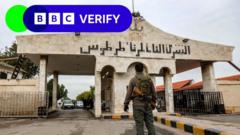The recent arrival of two Russian naval vessels at the Tartous port in Syria raises significant questions about the future of Russia's military engagement in the region. The ships, known as the Sparta and Sparta II, have been linked to the transportation of military assets and were previously positioned in the Mediterranean Sea, indicating potential preparations for a withdrawal.
Analysts suggest that these moves coincide with reports of Russia losing its lease on the Tartous naval base, traditionally a critical hub for Russian operations in the Mediterranean. This development follows the collapse of the Assad regime, which Russia had supported throughout the prolonged Syrian civil war. Reports in Syrian media hint at a transition of authority in Damascus, although official confirmations remain absent from both Syrian and Kremlin spokespeople.
Surveillance images from the EU's Sentinel satellites indicate an assembly of military hardware at the port, suggesting a significant accumulation of military resources that may soon be evacuated. Experts argue that the military presence at Tartous may not be tenable any longer, given the political shifts and the reported cancellation of Russia's lease. Analysts like Frederik Van Lokeren note that the presence of military vessels, such as Ivan Gren and Alexander Otrakovsky, further hints at a systematic evacuation strategy.
This anticipated withdrawal from Syria aligns with ongoing movements of Russian military personnel and equipment to airbases in Libya, augmenting Russian support for the Khalifa Haftar-led faction in the ongoing Libyan conflict. As operations in Libya grow more pronounced, concerns arise regarding the repurposing of Russian resources and military strategies across the region.
Despite these transitions, the Hmeimim airbase remains active, reported through satellite imagery showing the loading of military equipment onto Russian aircraft. The integration of Russian military operations in Libya illustrates a broader realignment of Russian defense capabilities under Moscow's military directives, potentially consolidating control over interests previously occupied by groups like the Wagner Group.
As the dynamics in the Middle East evolve, the implications of a reduced Russian footprint in Syria are manifold. Observers note that the shift could influence regional power structures, raise operational questions regarding Russian military assets, and highlight changing alliances amid a volatile geopolitical landscape. The shifting presence of Russia's naval forces in Syria serves as a pivotal indication of changing conditions, reflecting a delicate balance of power in a historically contentious region.




















